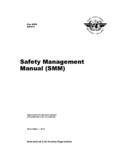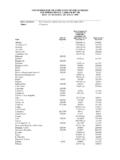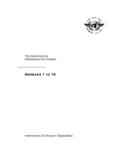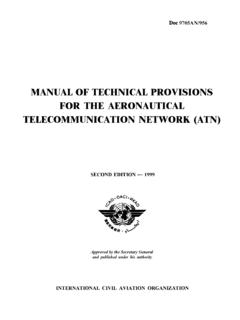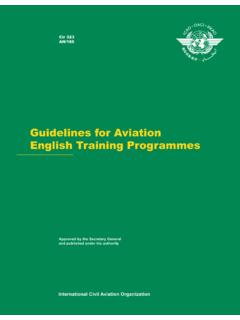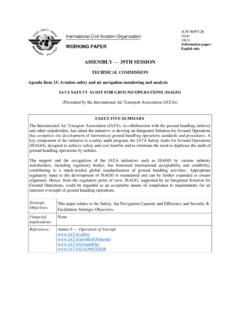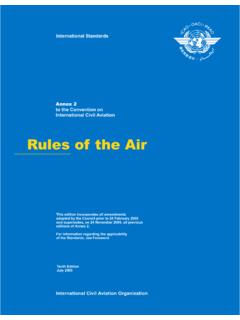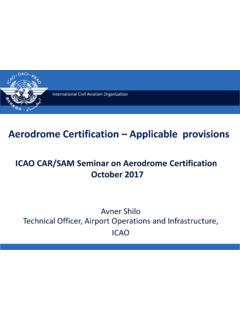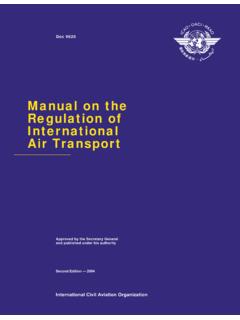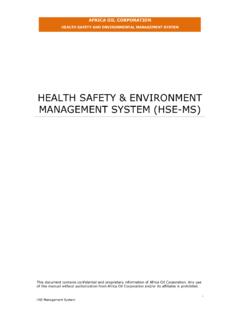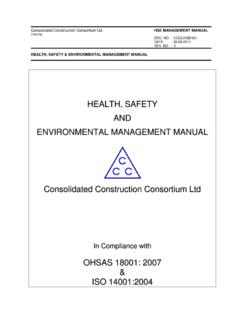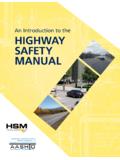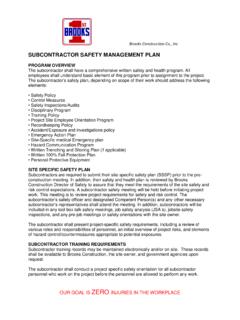Transcription of FATIGUE RISK MANAGEMENT SYSTEM (FRMS) …
1 FATIGUE RISK MANAGEMENT SYSTEM (FRMS) IMPLEMENTATION GUIDE FOR OPERATORS TABLE OF CONTENTS July 2011 Page 1 INTENTIONALLY LEFT BLANK FATIGUE RISK MANAGEMENT SYSTEM (FRMS) IMPLEMENTATION GUIDE FOR OPERATORS July 2011 Page 1 EXECUTIVE LETTER Dear Colleagues, Air travel continues to be the safest means of transportation, but that does not allow for us to become complacent. We continually strive for improvements in our industry safety record, which is a testament to our ongoing commitment to safety . FATIGUE Risk MANAGEMENT Systems (FRMS) continues the move from prescriptive to performance based regulatory oversight. As in safety MANAGEMENT Systems (SMS), FRMS strives to find the realistic balance between safety , productivity and costs in an organization, through collection of data and a formal assessment of risk.
2 Traditionally, crewmember FATIGUE has been managed through prescribed limits on maximum flight and duty hours, based on a historical understanding of FATIGUE through simple work and rest period relationships. New knowledge related to the effects of sleep and circadian rhythms provides an additional dimension to the MANAGEMENT of FATIGUE risks. An FRMS provides a means of adding this safety dimension, allowing operators to work both safer and more efficiently. This FRMS Implementation Guide for Operators is a significant milestone. It marks the successful collaboration between IATA, IFALPA and ICAO to jointly lead and serve industry in the ongoing development of FATIGUE MANAGEMENT , using the most current science. The input of these three organizations has ensured that this document presents a scientifically-based approach that is widely acceptable to the operators and the crew members who will be using it.
3 It also offers this information in an accessible and practical way to assist implementation. We are extremely proud to mutually introduce this FRMS Implementation Guide for Operators, which will contribute to the improved MANAGEMENT of FATIGUE risk, and to ultimately achieve our common goal of improving aviation safety worldwide. Guenther Matschnigg Senior Vice President safety , Operations & Infrastructure, IATA Nancy Graham Director Air Navigation Bureau ICAODon Wykoff President International Federation of Air Line Pilots Associations FATIGUE RISK MANAGEMENT SYSTEM (FRMS) IMPLEMENTATION GUIDE FOR OPERATORS Page 2 July 2011 DISCLAIMER The information contained in this publication is subject to constant review in the light of changing government requirements and regulations.
4 No subscriber or other reader should act on the basis of any such information without referring to applicable laws and regulations and without taking appropriate professional advice. Although every effort has been made to ensure accuracy, the International Air Transport Association (IATA), the International Civil Aviation Organization (ICAO), the International Federation of Airline Pilots Associations (IFALPA), and other contributors to this publication shall not be held responsible for any loss or damage caused by errors, omissions, misprints or misinterpretation of the contents hereof. Furthermore, the International Air Transport Association, the International Civil Aviation Organization, the International Federation of Airline Pilots Associations, and the contributors to this publication expressly disclaim any and all liability to any person or entity, whether a purchaser of this publication or not, in respect of anything done or omitted, and the consequences of anything done or omitted, by any such person or entity in reliance on the contents of this publication.
5 Opinions expressed in this publication do not necessarily reflect the opinion of the International Air Transport Association, International Civil Aviation Organization, nor the International Federation of Airline Pilots Associations. The mention of specific companies, products in this publication does not imply that they are endorsed or recommended by the any of the above in preference to others of a similar nature which are not mentioned. No part of this publication may be reproduced, recast, reformatted or transmitted in any form by any means, electronic or mechanical, including photocopying, recording or any information storage and retrieval SYSTEM , without the prior written permission of the authors. FATIGUE RISK MANAGEMENT SYSTEM (FRMS)IMPLEMENTATION GUIDE FOR OPERATORSTABLE OF CONTENTS July 2011 Page 1 TABLE OF CONTENTS INTRODUCTION TO WHAT IS A FATIGUE RISK MANAGEMENT SYSTEM ?
6 1 WHY THE AVIATION INDUSTRY IS INTRODUCING ICAO REQUIREMENTS FOR FATIGUE RISK MANAGEMENT STRUCTURE OF THIS SCIENCE FOR ESSENTIAL SLEEP What is Happening in the Brain During Sleep ..1 The Issue of Sleep Quality ..5 Consequences of Not Getting Enough INTRODUCTION TO CIRCADIAN Examples of Circadian Rhythm ..10 The Circadian Body Clock and 3 Sensitivity of the Circadian Body Clock to Light ..14 Shift Work .. 15 Jet Lag ..17 SUMMARY OF ESSENTIAL SCIENCE FOR FRMS ..20 FRMS POLICY AND DOCUMENTATION ..1 FRMS Scope of the FRMS ..3 Things that the FRMS Policy Must Cover ..4 EXAMPLES OF FRMS POLICY FRMS Policy Statement for a Major Air FRMS Policy Statement for a Small Operator Providing Medical Evacuation Services.
7 7 FRMS Example of Terms of Reference for a FATIGUE safety Action Group ..9 FATIGUE RISK MANAGEMENT (FRM) PROCESSES ..1 INTRODUCTION TO FRM FRM PROCESSES STEP 1: IDENTIFY THE OPERATIONS FRM PROCESSES STEP 2: GATHER DATA AND FRM PROCESSES STEP 3: HAZARD Predictive Hazard Identification Processes ..8 Proactive Hazard Identification Processes ..11 Reactive Hazard Identification Processes ..18 FRM PROCESSES STEP 4: RISK FRM PROCESSES STEP 5: RISK EXAMPLE: SETTING UP FRM PROCESSES FOR A NEW ULR Step 1 Identify the Step 2 Gather Data and Information ..24 Step 3 Identify Hazards ..26 Step 4 Assess safety Risk ..27 Step 5 Select and Implement Controls and Mitigations ..27 FATIGUE RISK MANAGEMENT SYSTEM (FRMS) IMPLEMENTATION GUIDE FOR OPERATORS TABLE OF CONTENTS Page 2 July 2011 Step 6 Monitor Effectiveness of Controls and Linking to FRMS safety Assurance FRMS safety ASSURANCE INTRODUCTION TO FRMS safety ASSURANCE FRMS safety ASSURANCE PROCESSES STEP 1: COLLECT AND REVIEW FRMS safety ASSURANCE PROCESSES STEP 2: EVALUATE FRMS FRMS safety ASSURANCE PROCESSES STEP 3: IDENTIFY EMERGING FRMS safety ASSURANCE PROCESSES STEP 4: IDENTIFY CHANGES AFFECTING FRMS.
8 9 FRMS safety ASSURANCE PROCESSES STEP 5: IMPROVE EFFECTIVENESS OF ASSIGNING RESPONSIBILITY FOR FRMS safety ASSURANCE EXAMPLES OF FRMS safety ASSURANCE PROCESSES INTERACTING WITH FRM FRMS PROMOTION PROCESSES ..1 INTRODUCTION TO FRMS PROMOTION FRMS TRAINING Who Needs to be Trained ..2 Curriculum ..2 FRMS Training Formats and Frequency ..6 FRMS Training Evaluation ..7 FRMS Training Documentation ..8 FRMS Communications Plan ..8 FRMS INTRODUCTION TO FRMS PHASE I: PHASE II: IMPLEMENT REACTIVE FRM PHASE IV: IMPLEMENT FRMS safety ASSURANCE OPERATIONAL EXAMPLE OF STAGED FRMS APPENDIX A: GLOSSARY ..1 APPENDIX B: MEASURING CREWMEMBER B1 CREWMEMBERS RECALL OF FATIGUE Reporting Retrospective Surveys.
9 3 B2 MONITORING CREWMEMBER FATIGUE DURING FLIGHT Subjective FATIGUE and Sleepiness Ratings ..5 Objective Performance Monitoring Monitoring the Circadian Body Clock Cycle ..19 B3 EVALUATING THE CONTRIBUTION OF FATIGUE TO safety APPENDIX C: PROCEDURES FOR CONTROLLED REST ON THE FLIGHT FATIGUE RISK MANAGEMENT SYSTEM (FRMS)IMPLEMENTATION GUIDE FOR OPERATORSINTRODUCTION TO FRMS July 2011 Page 1 INTRODUCTION TO FRMS The purpose of this FRMS Implementation Guide is to provide air operators with information for implementing an FRMS that is consistent with ICAO Standards and Recommended Practices (SARPs). As the ICAO provisions for FRMS evolve, every effort will be made to keep this manual up to date. However, it is recommended that operators check the current SARPs to find out if anything important has changed since this version of the manual was developed.
10 Operators also need to ensure that their FRMS meets the requirements of their State s regulatory authority. A variety of options to address the ICAO Standards for an FRMS are presented throughout this guide. These can be adapted to the needs of different sizes and types of operators (international, domestic, passenger, cargo, etc) and to specific operations (Ultra-Long Range (ULR), long haul, short haul domestic, on-call/charter, etc). It is not necessary to implement all of these options to have an effective FRMS that meets regulatory requirements. WHAT IS A FATIGUE RISK MANAGEMENT SYSTEM ? Crewmember FATIGUE can be defined as: A physiological state of reduced mental or physical performance capability resulting from sleep loss or extended wakefulness, circadian phase, or workload (mental and/or physical activity) that can impair a crew member s alertness and ability to safely operate an aircraft or perform safety related duties.
